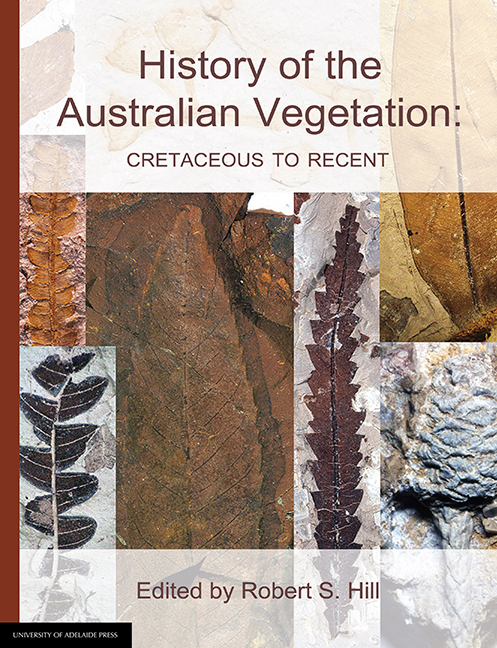Book contents
- Frontmatter
- Contents
- List of contributors
- Introduction to the 2017 edition
- 1 The Australian fossil plant record: an introduction
- 2 Maps of late Mesozoic-Cenozoic Gondwana break-up: some palaeogeographical implications
- 3 The background: 144 million years of Australian palaeoclimate and palaeogeography
- 4 Palaeobotanical evidence for Tertiary climates
- 5 Landscapes of Australia: their nature and evolution
- 6 Patterns in the history of Australia's mammals and inferences about palaeohabitats
- 7 Australian Tertiary phytogeography: evidence from palynology
- 8 Cretaceous vegetation: the microfossil record
- 9 Cretaceous vegetation: the macrofossil record
- 10 Early Tertiary vegetation: evidence from spores and pollen
- 11 The early Tertiary macrofloras of continental Australia
- 12 Cenozoic vegetation in Tasmania: macrofossil evidence
- 13 The Neogene: a period of transition
- 14 The Oligo-Miocene coal floras of southeastern Australia
- 15 Quaternary vegetation
- 16 The history of selected Australian taxa
- Taxonomic index
- General index
15 - Quaternary vegetation
Published online by Cambridge University Press: 25 July 2017
- Frontmatter
- Contents
- List of contributors
- Introduction to the 2017 edition
- 1 The Australian fossil plant record: an introduction
- 2 Maps of late Mesozoic-Cenozoic Gondwana break-up: some palaeogeographical implications
- 3 The background: 144 million years of Australian palaeoclimate and palaeogeography
- 4 Palaeobotanical evidence for Tertiary climates
- 5 Landscapes of Australia: their nature and evolution
- 6 Patterns in the history of Australia's mammals and inferences about palaeohabitats
- 7 Australian Tertiary phytogeography: evidence from palynology
- 8 Cretaceous vegetation: the microfossil record
- 9 Cretaceous vegetation: the macrofossil record
- 10 Early Tertiary vegetation: evidence from spores and pollen
- 11 The early Tertiary macrofloras of continental Australia
- 12 Cenozoic vegetation in Tasmania: macrofossil evidence
- 13 The Neogene: a period of transition
- 14 The Oligo-Miocene coal floras of southeastern Australia
- 15 Quaternary vegetation
- 16 The history of selected Australian taxa
- Taxonomic index
- General index
Summary
The Quaternary is the period of modern life in which all the kinds of plants and animals still living have evolved, or have continued from the Tertiary unaffected by new environments. Technically, the beginning of the Quaternary has been defined as the last phase of the Matuyama reversed magnetism epoch after the Olduvai event, which finished at 1.62 million years (Ma). Others relate it to the first appearance of arctic marine faunas about 2.2 Ma in the mid-latitude North Atlantic (Bowen, 1978). The period therefore breaks with the definitions of older periods based on widespread evolutionary changes and instead uses climatic changes, such as the growth of icesheets and spread of cold surface water, to establish the chronology. Cores from the sea-floor show that parts of the tropical Pacific were little affected, but the lock up of snow in icecaps left the oceans enriched in the heavy isotope of oxygen (18O), so that a record of ice on the earth is well preserved in marine sediments. This record shows a series of cyclic changes on time scales of about 100 ka, with phases of maximum and minimum ice extent (stadial and interglacial periods, respectively), each occurring for 10% of each cycle, the remainder being cool interstadials (Chappell & Shackle - ton, 1986). Over 20 of these alternations have been identified, showing that for the last 2.3 Ma the earth has been very sensitive to minor changes in thermal equilibria, forced, in part at least, by variations in the season and amount of solar radiation reaching the earth (Chappell & Grindrod, 1983).
There are only two divisions in the Quaternary: the Pleistocene from 2.2 (or 1.62) Ma to only 10 ka ago, and the Holocene, our present interglacial, which is the last 10 000 years. The Pleistocene represents the period of establishment of our present landscapes, climatic patterns and types of variability, and the adaptation of the Tertiary biota to these new environments. The term Holocene means life as at present and this is generally true in relation to evolution - the time has been far too short for major new species to appear.
- Type
- Chapter
- Information
- History of the Australian VegetationCretaceous to Recent, pp. 368 - 389Publisher: The University of Adelaide PressPrint publication year: 2017



